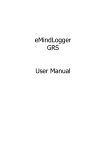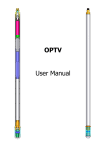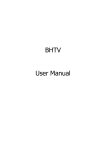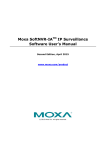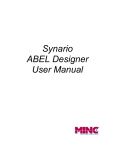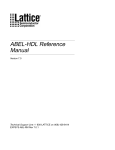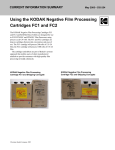Download FWS User Manual
Transcript
FWS User Manual Before you start... ...................................................................................................................... 3 1. The main program window ................................................................................................... 4 1.1 Depth, logging speed and display configuration panel............................................................. 5 1.2 Sonde data replay and recording controls ................................................................................ 7 2. System and probe configuration ........................................................................................... 9 2.1 Winch settings.............................................................................................................................. 9 2.2 Probe settings............................................................................................................................. 10 2.3a Communication configuration and status display................................................................ 12 2.3b Automatic communication settings tool ................................................................................ 12 2.4 Data acquisition configuration ................................................................................................. 14 2.5 Automatic and manual trace gain settings .............................................................................. 15 3. Program menus ................................................................................................................... 16 3.1 File menu .................................................................................................................................... 16 3.1.1 Open and replay a log: load a data file for replay................................................................................ 16 3.1.2 Export a file:........................................................................................................................................ 17 3.1.2.1 Format SEG2 ............................................................................................................................... 17 3.1.2.2 Format LAS 2.0 ........................................................................................................................... 17 3.1.3 Record a new log................................................................................................................................. 18 3.1.3.1 Log header: client and borehole site ............................................................................................ 19 3.1.3.2 Log header: log datum information.............................................................................................. 19 3.1.3.3 Log header: borehole information................................................................................................ 20 3.1.3.4: Log header: borehole diameter and casing information.............................................................. 20 3.1.3.5 : Log header: other remarks ......................................................................................................... 21 3.1.4 Printing ................................................................................................................................................ 22 3.1.4.1 Print.............................................................................................................................................. 22 3.1.4.2 Auto Print..................................................................................................................................... 22 3.1.4.3 Printing configuration. ................................................................................................................. 22 3.1.5 Exit ...................................................................................................................................................... 22 3.2 Tools menu ................................................................................................................................. 22 4. Appendices :......................................................................................................................... 24 4.1 Example EmFws.tol configuration file .................................................................................... 24 4.2 Example probe import *.fwc file.............................................................................................. 24 4.3 What to do if … ......................................................................................................................... 25 The data window depth scale does not display correctly.............................................................................. 25 An error message « Can't load FTD2xx.dll » appears .................................................................................. 25 How to add an additional sonde for use with the system ?........................................................................... 25 I would like to change the screen refresh rate .............................................................................................. 25 FWS User manual A.Declaye Electromind ©2007 r1.0 2 Before you start... This software is supplied with the files necessary for the operation of the sonde(s) for which it was developed and has been optimised to operate under Microsoft Windows XP in mode 32-bit colour. On connecting the Electromind logger acquisition system to your computer for the first time, you will be asked to install the USB drivers. The necessary files and installation documentation can be found both in the subdirectory “Driver” of the FWS application on your hard-disk and on the supplied FWS installation CDROM. These files are also available for download from our web site www.electromind.eu by following the link to the Software demos/updates page and clicking on Full package v1.06.06 with user guide FR & UK under Installation of the USB driver. The FWS software generates and maintains a global configuration file (emFWS.tol) that incorporates configuration information for each Full Wave Sonic probe installed on your system. A file appropriate to the hardware supplied will have been installed on your system along with this program. Be attentive to the fact that the erasure or inappropriate modification of this file can lead to incorrect system operation and, in some cases, even damage to your down hole probe. A functional .tol file can, if necessary, be regenerated by deleting all installed probes from your system and re-importing them using the relevant text format Full Wave Sonic sonde import file (sonde_name.fwc), also supplied on your installation CDROM. A sample data file (*.fwe) is also included in the software installation package. Following installation, these files can be located in the « Demo » subdirectory of your chosen application installation location. This file allows the user to become familiar with the use of the software in replay mode. Recommended minimum system configuration: Intel Pentium XXX MHz/ AMD Athlon 1800 – 256 MB RAM – 1 free USB port OS: Microsoft Windows XP (SP1) or Microsoft Windows 2000. FWS User manual A.Declaye Electromind ©2007 r1.0 3 1. The main program window Fig.1.0 Main programme window with control panel and data display zones The main program window is divided into several areas concerned with different aspects of the sonde configuration and logging operations. The current sonde depth, logging speed and a number of other parameters are displayed in the upper left part of the screen (Fig.1.2). In the upper right part of the control panel are found the different controls and information for sonde power switching and data acquisition or replay (Fig.1.5). A status bar in the lower part of the screen provides additional information concerning system status, data transmission and the recording in progress (Fig.1.1). Additionally, the programme menu bar allows access to other functions related to data recording or replay and sonde or system configuration options. The program status bar information display: Data file being acquired or replayed System/USB information Reception status Data packet counters Probe power on/off Fig. 1.1 FWS User manual A.Declaye Transmit Receive Electromind ©2007 r1.0 4 1.1 Depth, logging speed and display configuration panel Reference = probe bottom Fig. 1.2a Replay mode Reference = probe top Fig. 1.2b Acquisition mode – automatic natural gamma scaling The current tool depth and logging speed are updated continuously in real time while the Logger is powered on and connected to the logging computer’s USB port. While in acquisition mode, the depth display (in yellow) indicates the current depth of the probe. The depth display becomes blue when the logger is powered off or when operating in replay mode. In the latter case, the depth display indicates the point reached in the data file replay. The log data display depth scale can be selected from this drop down list box at the extreme left of the panel. To the right of the depth scale display is located a drop-down list control allowing the user to choose from various available data display modes. This panel also provides an indication of the maximum possible logging speed A double-click on the depth reference icon the bottom of the probe, or vice-versa. changes the log depth reference from the top to Fig. 1.2c Acquisition mode – manual natural gamma scaling For probes equipped with a natural gamma detector, these values can be displayed in either automatic or manual scaling modes. In the first of these cases (see Fig 1.2b), the scale maximum is adjusted automatically according to the highest value read by the probe. In manual mode (Fig 1.2c), an additional button appears in the panel allowing the user to set the scale maximum to a chosen fixed value. FWS User manual A.Declaye Electromind ©2007 r1.0 5 Natural gamma Click on this button to set the natural gamma maximum scale Fig 1.2d Setting the natural gamma maximum display scale value. Setting the manual or automatic natural gamma scale option is achieved via the Probe tab of the Logger Setup dialogue box which is opened either by clicking on the the upper right hand corner of the main program window or selecting Tools, Communication from the program menu. button in This part of the display will only appear when the probe in use is equipped with a natural gamma detector. This part of the program window also displays the serial number of the probe currently connected to the system. Clicking on the magnifying glass icon in the upper left part of this panel opens an enlarged depth display window as shown below: Fig.1.3 Depth scale in m This display window, which also provides the current logging speed, can be closed either by double-clicking on it or by clicking on the close window button in its upper right-hand corner. The depth setting button allows the operator to enter an initial depth value prior to commencing a logging run, providing that the logger is connected and powered on and that the logging tool is not powered on. (Fig.1.4). The depth value entered at this point should correspond to the depth offset between the probe head connector locking collar and the chosen log depth reference (e.g. ground level, top of casing). When the probe head connector locking collar is located above the log depth reference level a negative offset should be entered. Fig.1.4 Thereafter, the current tool depth can be displayed in one of two ways : with respect to the probe head connector locking collar or, alternatively, with respect to the bottom of the FWS User manual A.Declaye Electromind ©2007 r1.0 6 probe. Double-clicking on the sonde icon to the right of the depth value display will switch the depth display between these modes, with the icon changing accordingly. Depth at sonde top displayed: Å Æ Depth at sonde bottom displayed: With the sonde powered on, the data display mode can be chosen by means of the button from the three possible options: depth up, depth down and time. The log data display depth scale can be selected from this drop-down list box at the extreme left of the panel. 1.2 Sonde data replay and recording controls Fig. 1.5a Replay mode Fig.1.5b Acquisition mode Fig. 1.5c Acquisition mode with status information This control panel changes according to how the software is currently being used : In replay mode (fig. 1.5a). The control buttons operate as for a video recorder. The timer display opens as soon the play button is clicked to start log replay. File replay speed can be adjusted with the sliding cursor control . A replay in progress can be stopped temporarily by means of the pause button: and, while in pause mode, the restart button allows a replay to be restarted from the beginning of the current data file. will terminate the replay in progress. Clicking on the stop button Acquisition mode (fig.1.5b): once the logger is correctly connected and switched on, the becomes visible. After checking that system is configured correctly probe power button for the sonde by means of the button (logging cable type, and sonde power voltage), the sonde can be powered up to begin the recording of a log; the probe communication status being indicated by the “Probe Control” display. Alert messages will be displayed here in case FWS User manual A.Declaye Electromind ©2007 r1.0 7 of problems, such as the message appearing when excessive logging speed causes data loss. The start of data transmission is signalled by a “beep” from the system. The sonde function status is confirmed by the indicator at the lower right of the main programme window. As a further check on correct sonde operation, the sonde voltage and current consumption indicators will flash red in the case that abnormal values are detected. Recording a log (fig.1.5c): when the sonde is powered up and the communication with the sonde correctly configured, the « New log » menu option under « File » becomes available (see section 3.1.2) and the record button is activated. Either of these methods can be used to begin recording a new log. Confirmation that recording is taking place is given by the flashing record button , the incrementing data counter and the recording time clock (see Fig. 1.5d). Fig. 1.5d Stop recording : this is accomplished by clicking on the stop button or by switching off sonde power. A new log can then be started using the “File” – “New log” commands. FWS User manual A.Declaye Electromind ©2007 r1.0 8 2. System and probe configuration 2.1 Winch settings To access this configuration dialogue, click on the button from the main program window and then on the Winch tab of the setup dialogue box (Fig. 2.0). Fig. 2.0 By means of this dialogue box the user configures the software according to the parameters of the logging winch to be used: encoder direction and resolution, depth wheel circumference and logging cable type. To avoid potential damage to down hole probes, it is particularly important to verify that the system is set up for the correct type of logging cable. NB : Note that, to protect the logging system and connected probes, this configuration dialogue can only be accessed when probe power is switched off. In replay mode, certain parameter settings may be greyed out to prevent accidental system reconfiguration. FWS User manual A.Declaye Electromind ©2007 r1.0 9 2.2 Probe settings To access this configuration dialogue, click on the button from the main program window and then on the Probe tab of the setup dialogue box (Fig. 2.1). Auto Manual Fig.2.1 The probe power supply voltage can be adjusted within the range authorised by the system (80 to 100 Vdc). The sonde to be used is selected, by means of its serial number, from a drop-down list control. This will cause the appropriate settings for the probe in question to be loaded from the global data base file « EmFws.tol ». Adding or deleting a probe: a new probe can be added to the configuration data base by clicking on the Add button. The required import file (*.fwc) will be supplied with your new equipment. The Remove button allows a no longer required sonde to be deleted from the system. The colour to be used for the First arrival traces in the left and right-hand tracks of the data display window can be chosen using the buttons located in the central part of the dialogue box. In the case where the selected probe is equipped with a natural gamma detector, the relevant zone of this dialogue box will be activated. A drop-down list box allows the user to choose from the three possible display modes: selecting the Hide option will deactivate the natural gamma bar-graph display; in Manual mode the user sets a fixed maximum scale value for the display (values exceeding this limit are nonetheless correctly recorded); finally an Auto mode is also available where the system adjusts the scale maximum automatically in line with the values being measured. When the Average check box is selected, a filter is applied to the natural gamma display, the smoothing effect of which is determined by the numeric value present in the adjacent control. FWS User manual A.Declaye Electromind ©2007 r1.0 1 Finally, for users having access to a suitable test site and/or equipment, the GammaCoeff setting allows the response of the sonde to be calibrated in order to directly obtain data values in API units. NB: Note that, to protect the logging system and connected probes, this configuration dialogue can only be accessed when probe power is switched off. In replay mode, certain parameter settings may be greyed out to prevent accidental system reconfiguration. FWS User manual A.Declaye Electromind ©2007 r1.0 1 2.3a Communication configuration and status display To access this configuration dialogue, click on the button from the main program window and then on the Communication tab of the setup dialogue box (Fig. 2.2a). Fig.2.2a Communication settings The surface to probe signal level (Down hole Signal Drive), probe to surface signal level (Up hole Signal Drive, acquisition module receiver amplification (Up hole Receiver Gain) and the up hole data transmission speed in Baud can all be adjusted by means of this dialogue, in order to optimise communications in both directions along the logging cable. A correctly configured system will minimise data loss caused by transmission errors. Communications status The lower part of this dialogue box comprises of a number of LED-type communications status indicators. • • • Data Valid GREEN B communications OK Parameter or Setting Update YELLOWB system reconfiguration taking place No Resp/Int Resp/Checksum Error/frame Length Error REDBindicates a communications problem caused by incorrect configuration or equipment breakdown. In replay mode, certain parameter settings may be greyed out to prevent accidental system reconfiguration. 2.3b Automatic communication settings tool This routine can be used to automatically adjust the relevant communications parameters in order to achieve maximum data transmission reliability. The procedure may require up to several minutes to complete, depending on the type and length of logging cable used. Assuming that the system has been able to successfully FWS User manual A.Declaye Electromind ©2007 r1.0 1 communicate with the connected probe, the software will propose to install the optimum settings for automatic future use. To run the automatic communication settings tool, click on the button Check in the communication configuration and status display. Fig.2.3a Click on start to being test. Fig.2.3b Establishing communications. Fig.2.3c Optimising the settings. Fig.2.3d Determine maximum baud rate Fig.2.3e End of the test Should it for any reason be impossible to complete an automatic communications check, the previously used values will be restored. FWS User manual A.Declaye Electromind ©2007 r1.0 1 2.4 Data acquisition configuration To access this configuration dialogue, click on the button from the main program window and then on the Acquisition tab of the setup dialogue box (Fig. 2.4). Fig.2.4 Trace length: these drop-down lists permit the user to choose, for each receiver with which the sonde is equipped, one of the four available acquisition trace configuration possibilities as follows: ¾ OFF = no acquisition with this receiver ¾ 1 mSec = 256 samples * 4 µs sample interval ¾ 2 mSec = 512 samples * 4 µs sample interval ¾ 4 mSec = 512 samples * 8 µs sample interval. Display: the receiver signals to be displayed in the left- and right-hand tracks of the data display window are selected by means of these two drop-down list controls. In the lower part of this dialogue window can be found the controls to modify time-mode and depth-mode sample intervals. NB: Note that, to protect the logging system and connected probes, this configuration dialogue can only be accessed when probe power is switched off. FWS User manual A.Declaye Electromind ©2007 r1.0 1 2.5 Automatic and manual trace gain settings Fig.2.5a Acquisition mode – automatic gain setting. Fig.2.5b Replay mode – automatic gain + first arrival. The sonic trace displays can be opened by clicking on the numbered buttons: located in the upper right hand corner of the main program window. Once opened they can be moved and resized as the user wishes. At this point it is useful to differentiate clearly between two of the functions accessible from the trace display window. The gain (amplification) applied to the received sonic signal can be adjusted manually or left in AGC (automatic gain control) mode. To select AGC (recommended), click on the check box in the bottom right corner of the trace display; otherwise set a value manually using the control located just above. A manual gain setting should be used with care – setting a too high value may result in signal « clipping » and/or loss of information. Independently of the gain setting, it is possible to apply a zoom to the trace display. This setting merely increases the amplitude of the signal displayed, by a factor from 1 to 64, and has no effect on the data recorded. To avoid the possibility of confusing the user, the zoom factor is always reset to a value of 1 on launching the programme or on changing the gain setting. With the FA button, the user opens a dialogue box to configure and activate a routine for the automatic detection of the first arrival. The configuration consists of defining the detection threshold (over a range of -127 to +127) and time interval window during which the software looks for the first received signal The colour of the trace used to represent the first arrival on the main display window can be set from the probe configuration dialogue, opened by clicking on the button from the main program window and then on the Probe tab of the setup dialogue box (see section 2.2). In replay mode, certain parameter settings may be greyed out to prevent accidental system reconfiguration. FWS User manual A.Declaye Electromind ©2007 r1.0 1 3. Program menus 3.1 File menu Fig.3.0 3.1.1 Open and replay a log: load a data file for replay Fig.3.1 Choose the Full Wave Sonic field data file (*.fwe) to be replayed by means of the dialogue box (Fig.3.1) that opens on clicking File, Open. Click on the Open button of the dialogue to load the data file for replay. The selected file name will appear in the program status bar and the file replay control buttons will be activated in the main program window. FWS User manual A.Declaye Electromind ©2007 r1.0 1 3.1.2 Export a file: 3.1.2.1 Format SEG2 Click on File, Export to, SEG-2. Choose the *.fwe file to be exported. A subsequent dialogue displays the start and end depths of the data file: the file can either be exported in its entirety by clicking on All, or over a certain interval by entering the start and end depths and clicking on Set. The generated files are placed in a directory named SEG2 that is created in the directory in which the chosen data file is located. A SEG2 format file is generated for each receiver trace contained in the field data file. 3.1.2.2 Format LAS 2.0 This option generates a LAS 2.0 format file containing natural gamma and detected first arrival values and certain other optional parameters. Note, however, that no sonic trace data is exported by this method. Start the procedure by clicking on the File, Export to, LAS 20 menu options and select a file in the dialogue box that will open at this point (Fig.3.2). If required for your application, select the check box Reverse depth to inverse the sense of the exported file. It is also possible to export only part of the field data file by entering start and end depths in this part of the dialogue box. Under Travel time the user can select the receiver traces for which he would like the program to generate an automatically detected first arrival curve and define the parameters relevant to this procedure – detection threshold and time window limits. Fig 3.2 By means of the check boxes under Displayed channels, the user can select from among the different parameters available those which are to be included in the exported LAS format file. FWS User manual A.Declaye Electromind ©2007 r1.0 1 3.1.3 Record a new log Begin this procedure by clicking on File, New log or on the record button this requires a probe to be connected and powered on. A dialogue box will then open, asking the user to confirm the type of log to be recorded (Fig.3.3). Fig.3.3 Once the log type has been selected, proceed to enter a file name for the log to be recorded. Fig.3.4 On clicking the OK button, the user will be prompted to choose a location and name for the data file to be created: for example c:\logdata\site1\borehole1\… There are no pre-defined file naming or directory conventions in this respect. Should, however, a file with the chosen name already exist in the selected location, the user will be prompted as to whether the existing file should be overwritten or the new recording be given a new file name. FWS User manual A.Declaye Electromind ©2007 r1.0 1 3.1.3.1 Log header: client and borehole site Fig.3.5 3.1.3.2 Log header: log datum information. Fig.3.6 FWS User manual A.Declaye Electromind ©2007 r1.0 1 3.1.3.3 Log header: borehole information. Fig.3.7 3.1.3.4: Log header: borehole diameter and casing information Fig.3.8 FWS User manual A.Declaye Electromind ©2007 r1.0 2 3.1.3.5 : Log header: other remarks Fig.3.9 FWS User manual A.Declaye Electromind ©2007 r1.0 2 3.1.4 Printing 3.1.4.1 Print By means of the File, Print menu commands, the user can produce hard-copy output of a file in course of recording or being replayed. 3.1.4.2 Auto Print With this option selected, the Print menu command is disabled and the user can no longer modify the log depth scale. Log data will be automatically sent to the printer, page by page, as a background task during recording, until such time as the user powers off the logging probe or de-selects this menu option. 3.1.4.3 Printing configuration. The File, Set Printer commands open the Windows printer setup dialogue. Fig.3.10 3.1.5 Exit The File, Exit commands will close the program. For safety and data security reasons, power off any connected probe and close any file recording in progress before quitting the program. 3.2 Tools menu Fig.3.11 FWS User manual A.Declaye Electromind ©2007 r1.0 2 Under this menu can be found the most important tools for system and probe configuration, as well as those involved in Clicking on Tools, Communication opens the principal set up and configuration window (see section 2.3a). The Tools, Extended Scope Rx* options will open the trace display for the relevant receiver channel. FWS User manual A.Declaye Electromind ©2007 r1.0 2 4. Appendices : 4.1 Example EmFws.tol configuration file [Commun] TotalChannel=12 [Sonde0] SerialNumber=0410 Length=300 RX_Number=3 OffsetRx1=50 OffsetRx2=100 OffsetRx3=150 Rx1_Name=2 FEET Rx2_Name=3 FEET Rx3_Name=4 FEET Natural_Gamma=yes Gamma_Offset=265 GammaCoef=1.00 . [Sonde1] SerialNumber=0429 SondeLength=266 RX_Number=2 . . Etc. # # # # # # # # # # # # # sonde reference for system (up to 10 sondes possible) probe serial number probe length number of receivers installed on probe offset in cm between base of probe and RX1 offset in cm between base of probe and RX2 offset in cm between base of probe and RX3 receiver 1 channel label receiver 2 channel label receiver 3 channel label yes/no according to whether natural gamma detector present offset in cm between base of probe and natural gamma detector natural gamma calibration coefficient 4.2 Example probe import *.fwc file [Sonde] Client=xxx SerialNumber=0627 SondeLength =277 RX_Number=2 OffsetRx1=57 OffsetRx2=87 OffsetRx3= Rx1_Name=3 FEET Rx2_Name=5 FEET Rx3_Name= Natural_Gamma=no Gamma_Offset= GammaCoef=1 FWS User manual A.Declaye # # # # # # # # # # # # # client company name probe serial number probe length number of receivers installed on probe offset in cm between base of probe and RX1 offset in cm between base of probe and RX2 offset in cm between base of probe and RX3 receiver 1 channel label receiver 2 channel label receiver 3 channel label yes/no according to whether natural gamma detector present offset in cm between base of probe and natural gamma detector natural gamma calibration coefficient Electromind ©2007 r1.0 2 4.3 What to do if … The data window depth scale does not display correctly. Check your display colour depth properties: The FWS program is optimised for 32-bit display colour depth. An error message « Can't load FTD2xx.dll » appears This message signifies that the USB driver is either not installed or of an incorrect version for your hardware. Restart the USB driver installation. The necessary files and installation documentation can be found both in the subdirectory “Driver” of the FWS application on your hard-disk and on the supplied FWS installation CDROM. These files are also available for download from our web site www.electromind.eu by following the link to the Software demos/updates page and clicking on Full package v1.06.06 with user guide FR & UK under Installation of the USB driver. How to add an additional sonde for use with the system ? The software is capable of being configured for up to 10 different probes identified by means of serial numbers. See section 2.2 of this document for information on the procedure regarding the configuration of the system for a new probe. I would like to change the screen refresh rate This is determined by the RefreshTime parameter of the EmFw.cfg file. Setting a higher value for this parameter can reduce system load in cases where your PC is at or close to the minimum required configuration. Browse to you FWS program directory (e.g. c:\eMindLogger\FWS logger) Make a back-up copy of your EmFw.cfg file Open your original EmFw.cfg file in Notepad Search for the heading: [eMindLogger] Modify the following parameter: RefreshTime = xx where XX represents the screen redraw interval in milliseconds (minimum value 50) Save the edited file. FWS User manual A.Declaye Electromind ©2007 r1.0 2

























